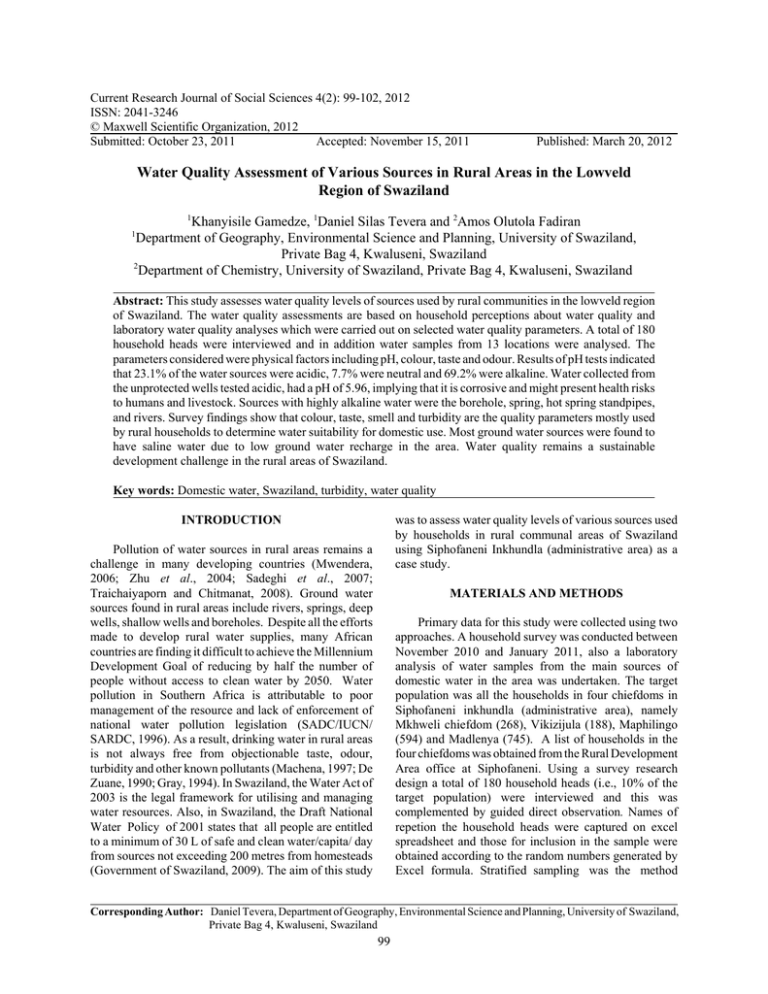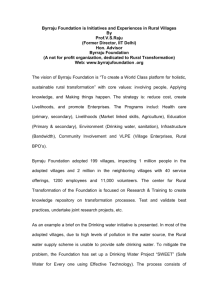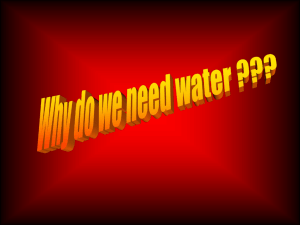Current Research Journal of Social Sciences 4(2): 99-102, 2012 ISSN: 2041-3246
advertisement

Current Research Journal of Social Sciences 4(2): 99-102, 2012 ISSN: 2041-3246 © Maxwell Scientific Organization, 2012 Submitted: October 23, 2011 Accepted: November 15, 2011 Published: March 20, 2012 Water Quality Assessment of Various Sources in Rural Areas in the Lowveld Region of Swaziland 1 Khanyisile Gamedze, 1Daniel Silas Tevera and 2Amos Olutola Fadiran 1 Department of Geography, Environmental Science and Planning, University of Swaziland, Private Bag 4, Kwaluseni, Swaziland 2 Department of Chemistry, University of Swaziland, Private Bag 4, Kwaluseni, Swaziland Abstract: This study assesses water quality levels of sources used by rural communities in the lowveld region of Swaziland. The water quality assessments are based on household perceptions about water quality and laboratory water quality analyses which were carried out on selected water quality parameters. A total of 180 household heads were interviewed and in addition water samples from 13 locations were analysed. The parameters considered were physical factors including pH, colour, taste and odour. Results of pH tests indicated that 23.1% of the water sources were acidic, 7.7% were neutral and 69.2% were alkaline. Water collected from the unprotected wells tested acidic, had a pH of 5.96, implying that it is corrosive and might present health risks to humans and livestock. Sources with highly alkaline water were the borehole, spring, hot spring standpipes, and rivers. Survey findings show that colour, taste, smell and turbidity are the quality parameters mostly used by rural households to determine water suitability for domestic use. Most ground water sources were found to have saline water due to low ground water recharge in the area. Water quality remains a sustainable development challenge in the rural areas of Swaziland. Key words: Domestic water, Swaziland, turbidity, water quality INTRODUCTION was to assess water quality levels of various sources used by households in rural communal areas of Swaziland using Siphofaneni Inkhundla (administrative area) as a case study. Pollution of water sources in rural areas remains a challenge in many developing countries (Mwendera, 2006; Zhu et al., 2004; Sadeghi et al., 2007; Traichaiyaporn and Chitmanat, 2008). Ground water sources found in rural areas include rivers, springs, deep wells, shallow wells and boreholes. Despite all the efforts made to develop rural water supplies, many African countries are finding it difficult to achieve the Millennium Development Goal of reducing by half the number of people without access to clean water by 2050. Water pollution in Southern Africa is attributable to poor management of the resource and lack of enforcement of national water pollution legislation (SADC/IUCN/ SARDC, 1996). As a result, drinking water in rural areas is not always free from objectionable taste, odour, turbidity and other known pollutants (Machena, 1997; De Zuane, 1990; Gray, 1994). In Swaziland, the Water Act of 2003 is the legal framework for utilising and managing water resources. Also, in Swaziland, the Draft National Water Policy of 2001 states that all people are entitled to a minimum of 30 L of safe and clean water/capita/ day from sources not exceeding 200 metres from homesteads (Government of Swaziland, 2009). The aim of this study MATERIALS AND METHODS Primary data for this study were collected using two approaches. A household survey was conducted between November 2010 and January 2011, also a laboratory analysis of water samples from the main sources of domestic water in the area was undertaken. The target population was all the households in four chiefdoms in Siphofaneni inkhundla (administrative area), namely Mkhweli chiefdom (268), Vikizijula (188), Maphilingo (594) and Madlenya (745). A list of households in the four chiefdoms was obtained from the Rural Development Area office at Siphofaneni. Using a survey research design a total of 180 household heads (i.e., 10% of the target population) were interviewed and this was complemented by guided direct observation. Names of repetion the household heads were captured on excel spreadsheet and those for inclusion in the sample were obtained according to the random numbers generated by Excel formula. Stratified sampling was the method Corresponding Author: Daniel Tevera, Department of Geography, Environmental Science and Planning, University of Swaziland, Private Bag 4, Kwaluseni, Swaziland 99 Curr. Res. J. Soc. Sci., 4(2): 99-102, 2012 Fig. 1: Map of Siphofaneni area showing the sampled households and their domestic water sources employed in this study whereby households were sampled from each of the four chiefdoms on the basis of population proportionality and this was done to ensure adequate representation. The simple random sampling procedure was used to determine the household heads who were interviewed in the eight communities within the four chiefdoms (Fig. 1). Numerical values were allocated to each homestead and then randomly selected to be part of the sample. The questionnaire was pilot tested to ascertain its validity and adequacy of the sampling variability within the population to be surveyed. To assess the water from the sources of water studied for quality, water samples were collected from 13 locations in Siphofaneni using sterilised glass bottles and transported to the laboratory in a cold box for analysis. The sampling locations were as follows: Madlenya borehole (S1); Duze unprotected well (S2); Lukhetseni spring (S3); Mshumpula stream (S4); Othandweni standpipe (S5); Lukhetseni hot spring (S6); Cota earth dam (S7); Phuzumola standpipe (S8); Sihlotjeni unprotected well (S9); Mtimpofu stream (S11); Mhlatuze river (S12); and Duze standpipe (S13). The parameters that were considered were physical factors like pH, colour, taste and odour. Most of the chemical and biological quality measures were neglected because the study discovered that they had nothing to do with the water collecting behaviour of rural households. As a result when respondents were asked about the quality of the water they used, only physical factors were mentioned and this indicated that to rural households, the quality parameters that matter the most in shaping water demand are the physical factors. RESULTS AND DISCUSSION The study discovered that 35.4% of the households in the study area relied on rivers as their main source of domestic water; 20.8% used communal standpipes; 12.8% used wells; 10.1% depended on private standpipes; 2.8% used boreholes and rainwater; and 6.7 and 0.7% used earth dams and springs, respectively. Only 35.6% of the respondents indicated that they used protected water sources that are surrounded by either thorny bushes, or fenced with wire. Reasons given for having most of the sources unprotected included that these sources are communally used and hard to protect because nobody takes the responsibility since everyone thinks it is everybody else’s responsibility. Figure 2 highlights the main challenges related to the water sources used for domestic purposes. Generally, households showed informed views about water quality issues in the area, with 40% expressing various concerns. The multiple response analysis indicated that the most cited challenges were the long distances (in some cases exceeding 2 km) of the water sources from the homesteads with 19.5% household heads reporting that the water sources are far away from the homesteads while 17.3% reported that water pollution was their major 100 Curr. Res. J. Soc. Sci., 4(2): 99-102, 2012 Table 1: Quality of water from various sources Sample Water source pH S1 Madlenya Borehole 8.72 S2 Duze Unprotected well 6.78 Colour Clear Dark Taste Saline Bitter S3 Lukhetseni S4 Mshumpula Spring Stream 9.13 7.03 Clear Clear tasteless Slightly saline S5 Othandweni S6 Lukhetseni S7 Cota S8 Phuzumola S9 Sihlotjeni Standpipe Hot spring Earth dam Standpipe Unprotected well 7.23 8.98 7.22 7.98 5.96 Clear Whitish Dark green Clear Whitish Saline Saline Sour Saline Saline S10 Siphofaneni River 7.38 Turbid Normal S11 Mtimpofu Stream 7.00 Clear Normal S12 Mhlatuze River 7.84 Turbid Normal S13 Duze Stand pipe 6.50 Clear Bitter 17.3% 12.4% 10.2% 8.5% 10.2% 4.1% 3.8% 4.0% 3.8% 0.5% Uses Drinking, cooking and bathing Drinking, cooking, washing clothes, bathing and animal drinking Bad odour Washing dishes, washing clothes and bathing Bad odour Washing, drinking, cooking, bathing, watering vegetables and animal drinking No smell Bathing, washing, cooking and drinking Bad odour Washing and bathing Bad odour Drinking, cooking, bathing and washing No smell Drinking, cooking, washing and bathing Bad odour Drinking, cooking, washing, bathing, and cleaning houses No smell Drinking, cooking, washing clothes, bathing, animal drinking and watering vegetables Urine odour Washing, drinking, cooking, bathing, watering vegetables and animal drinking No smell Animal drinking, washing, cooking, drinking, bathing, watering vegetables Chlorine smell Drinking, cooking, washing, bathing, and cleaning houses and was not good for washing or bathing as it leaves white patches on clothes or bodies of users. Respondents were asked how they ensured that the water from the sources was free from germs and other impurities. Only 25% of the households indicated that they treated the stored water using chemicals or by boiling it in order to decrease bacteriological health hazards. Also, the respondents were asked to state their views on how the government could help to improve the quality of water used for domestic use by the rural population. As many as 42% were of the opinion that government should drill communal boreholes fitted with pipes in order to ensure that the rural population has access to clean water. As a follow up on the water quality survey of household perceptions about water quality a laboratory water quality analysis was undertaken on selected domestic water quality parameters. Results of water quality analyses are shown in Table 1. The pH was measured in order to establish whether the water was acidic and presented a threat to human health. A pH of lower than 7 indicates that the water is acidic while a value above 7 shows that it is alkaline. The normal range for surface water is a pH of 6.5-8.5 and for groundwater is 6-8.5 (Manahan, 2000; Pierce et al., 1998). The pH tests conducted for the selected water sources indicated that the area is characterised by a wide range of acidic and alkaline water sources. Water collected from the unprotected wells was acidic, dark, tasted bitter and had a bad odour (Table 1). The most striking acidic water source with a pH of 5.96 was Sihlotjeni well which serves Madlenya 1 and Mkhweli communities. This implies that the water is corrosive and might present some health risks to humans and animals. The communal standpipe at Mkhweli chiefdom, which supplies households at Phuzumoya with treated water, was found to be acidic, implying that the chlorine levels in the water are high. The Madlenya borehole, Lukhetseni springs, standpipes, and Othandweni and Phuzumola rivers had alkaline water (Table 1). 19.5% 5.2% 0.5% P Co ollut n ta i mi on n Ina ation Di de rtie d b quac So urc y ya ee nim xp als en s ive Sali So ni urc t ed So o m a ty urc i rie su e f ntain ar Fre p in som away que nt e pum mo p b nths rea kag S So t e urc Sou eepy r ce ed slo iffi pe un r cul t to eliab m a le int ain Co n fl icts 20.0% 18.0% 16.0% 14.0% 12.0% 10.0% 8.0% 6.0% 4.0% 2.0% 0.0% Smell No smell Bad odour Types of challenge Fig. 2: Challenges associated with water sources challenge. Worth noting is that 12.6% of the respondents stated that their main challenge was water contamination by lifestock while 10.2% were concerned about contamination of the sources by water collectors. As many as 10.1% reported water salinity as a major problem; 12.3% were concerned about the frequent drying up of water sources resulting in water shortages; 5.3% cited water conflicts; and 7.9% mentioned that they experienced frequent water pump breakages and periodic drying up of the sources, including water sources being difficult to maintain or the water sources being difficult to access due to poor location on steepy slopes. It was observed during the survey that some of the unprotected sources like the streams, rivers, wells, and hot springs were used in situ for livestock drinking, washing and bathing and generally have dirty water with bad odour. Also, households which relied on water from boreholes and community standpipes complained that it was salty 101 Curr. Res. J. Soc. Sci., 4(2): 99-102, 2012 Table 2: Classification of the water sources according to their pH values pH Range No. of Sources % Type 5.96-6.78 (<7.00) 3 23.1 Acidic 7.00 1 7.7 Neutral/normal 7.03-9.13 (>7.00) 9 69.2 Alkaline provides water at no cost to households. Since water quality remains a major challenge in rural areas, the government should organise awareness campaigns in order to sensitise the rural people and enable them to realise the need to treat water from the natural sources by boiling it. In addition, the government should consider subsidising water treatment chemicals so as to enable more rural households to buy water treatment chemicals. Water quality remains a sustainable development challenge in the rural areas of Swaziland and a lot more has to be done in the area of water pollution management. Colour, taste, smell and turbidity are the quality parameters mostly used by rural households to determine the water sources to be used. The study found that while some of the sources had clear water others had dark, dark green or whitish water. The Sihlotjeni unprotected well and the hot springs had water that was whitish in colour largely due to the presence of minerals in the soil and the soaps and detergents used when bathing or washing clothes in rivers. Cota earth dam and Duze unprotected well have dark green water because livestock drink from these sources and also because chemicals from the nearby dip tank easily get transmitted into the water. Water from the rivers was slightly turbid due to deposits of particulate matter and suspended sediment from eroded topsoil resulting from agricultural activities and occasional tropical rain storms. Large drop sizes are a common characteristic of tropical storms (LAL, 1985) and these contribute to erosion and the subsequent transportation of sediment in streams and rivers. Table 2 depicts the pH types and ranges of the various water sources investigated. Three, (or 23.1%) were acidic, nine, (or 69.2%) were alkaline while only one, (7.7%) was neutral/normal. Hence, most of the sources have alkaline water except for the unprotected wells and the Phuzumoya standpipe which has treated water. The only source with normal/neutral water with respect to the pH-value was the Mshumpula stream which is seasonal. These levels are typical of tropical rivers as tropical soils have pH values ranging between 5.8-7.5 (Payne, 1986). The taste of the water from the different sources varied from normal, saline to bitter. Most ground water tasted salty due to low rainfall and low ground water recharge in the lowveld region. The water at unprotected sources was mostly shared between human beings and livestock and it tasted slightly sour and had an unpleasant urine odour. ACKNOWLEDGMENT The authors thank Swaziland Water Services Corporation for co-funding the research work that enabled us to write this study. REFERENCES De Zuane, J., 1990. Drinking Water Quality, Standards and Controls. Van Nostrand-Reinhold, New York. Government of Swaziland, 2009. Final Draft National Water Policy, Government of Swaziland, Mbabane. Swaziland. Gray, N.F., 1994. Drinking Water Quality, Problems and Solutions. John Wiley, New York. Lal, R., 1985. Soil erosion and sediment transport research in Tropical Africa. Inter. Hydrological Sci. J., 30(2): 239-256. Machena, C., 1997. The pollution and self-purification capacity of the Mukuvisi River. In: Moyo, (Ed.), Lake Chivero: A polluted lake, University of Zimbabwe, Harare, pp: 75-91. Manahan, S., 2000. Fundamentals of Environmental Chemistry. 2nd Edn., Lewis Publishers, London. Mwendera, E.J., 2006. Rural Water Supply and Sanitation (RWSS) coverage in Swaziland: toward achieving millennium development goals. Phys. Che. Earth, 31: 681-689. Payne, A.I., 1986. The Ecology of Tropical lakes and Rivers. John Wiley and Sons, Chichester. Pierce, J.J., P.A. Vesilind and R.F. Weiner, 1998. Environmental Pollution. 4th Edn., ButterworthsHeineman, Boston. SADC/IUCN/SARDC, 1996. Water in Southern Africa. SADC/IUCN/SARDC, Maseru/Harare. Sadeghi, G.H., M. Mohammadian, M. Nourani, M. Peyda and A. Eslami, 2007. Microbiological quality assessment of rural drinking water supplies in Iran. J. Agri. Soc. Sci., 3(1): 31-33. Traichaiyaporn, S. and C. Chitmanat, 2008. Water quality monitoring in upper ping river, Thailand. J. Agri. Soc. Sci., 4: 31-34. Zhu, K., L. Zhang, W. Hart, M. Liu and H. Chen, 2004. Quality issues in harvested rainwater in arid and semi-arid Loess Plateau of Northern China. J. Arid Environ., 57(4): 487-505. CONCLUSION Improving the quality and quantity of water supplies remains a priority for rural development in many African countries. The study filled a research gap by contributing knowledge on quality of domestic water in rural areas of Swaziland. The results reveal that most households still use unprotected water sources for domestic purposes. The study concluded that the unprotected water sources are used due to lack of alternative good quality water sources. The quality of water obtained from these sources is poor but rural households continue to use these sources for different domestic purposes because of the absence of alternative improved sources. Most households in Swaziland still use the river because it is a source that 102





